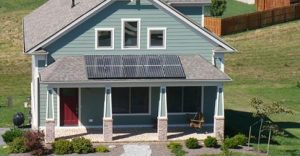Dec 31, 2014
2014 Solar Year in Review: Business Model Innovation and Consumer Demand Outpace Virginia Policy
We wish to highlight the solar industry’s successes in 2014 in developing record-breaking generation capacity nationally and innovative business models serving Virginian’s demand for solar. While Virginia policy still lags well behind consumer demand, Virginian’s have reason to remain optimistic for 2015 and beyond.
National industry figures and trends: Setting the Stage
According to the Solar Market Insight Report 2014 Q3, the United States is now home to 578,000 individual solar installations, representing a cumulative 16.1 Gigawatts of PV generating capacity.
At the end of Q3 2014, solar accounted for 36% of new generating capacity nationally. States such as North Carolina (3rd) and Maryland (12th) rank at the top of Q3 PV installations by state, installing over 100 MW combined of new solar, while Virginia again finds itself in the bottom half at 27th.
Industry in Virginia: Solarize Responding to the Demands of Consumers
While most Virginia policies lag behind consumer demand for solar, residents are taking hold of the reins with community-based Solarize programs. These innovative bulk-purchase programs are serving the desire for households to turn towards solar to generate their electricity, providing opportunities for cost-savings upfront, and even potential loan programs eliminating upfront capital altogether.

Beginning with Solarize Blacksburg in early 2014, over 10 different localities and thousands of residents throughout Virginia have signed up to participate in Solarize and Co-op programs, drawing on a “Costco” model and collective consumer demand to push the residential solar market to unprecedented heights in Virginia.
Secure Futures 2014 year in review: Business Model Innovation
As the residential solar market innovates in Virginia, Secure Futures pursued innovate business models that increase the viability of solar for commercial and tax-exempt institutions.
Business Model Development: Following 2013, Secure Futures revamped its business model, providing customers with high demand charges the ability to go solar with no upfront capital investment, paying for solar electricity at below Dominion and APCo electric rates.
Business Model Innovation: Power Purchase Agreements are limited to Dominion Virginia Power service territory, leaving the majority of Virginians with no ability to enter into financing arrangements for solar.

Secure Futures, with the help of Richmond attorneys at GreeneHurlocker PLC, developed the Solar Customer Self Generation Agreement (Solar CSGA™) to serve customers outside of Dominion service territory. The Maryland, D.C., and Virginia Solar Energy Industry Association recognized the Solar CSGA in November with the Solar Innovation Award for reducing barriers to solar development.
Over 2 MW of New Solar Contracts: Secure Futures doubled its future solar assets by signing two contracts to combine for over 700 kW, including the first PPA under the Dominion Pilot Program with the University of Richmond, and a phase II signature project with Eastern Mennonite University. A larger 1.3 MW project is under a Letter of Intent. The expected timetable for commissioning of the above projects is Q3 2015.
In Richmond: Legislators Faced With Rare Opportunity
Virginia as a whole remains well short of reaching its solar potential. Yet the Commonwealth is faced with a rare opportunity to respond to growing state budget deficits and EPA regulations by reducing barriers and providing some incentives for the fastest growing industry to invest and do business in Virginia. This is a luxury Virginia can ill-afford to ignore. Legislative action and stakeholder development will build on a modest foundation to support solar markets for 2015 and beyond.
Announcement of Solar Development Authority: In October, Gov. Terry McAuliffe unveiled the 2014 Virginia Energy Plan, recommending the establishment of the Solar Energy Development Authority, tasked with facilitating partnerships to install 15 MW of solar generation at state and local facilities by 2017, and an additionally 15 MW at commercial, industrial and residential facilities by the same period.
Proposed new Legislative Initiatives: stay tuned to this blog for proposed new initiatives for the 2014-15 legislative session to reduce barriers and increase incentives.